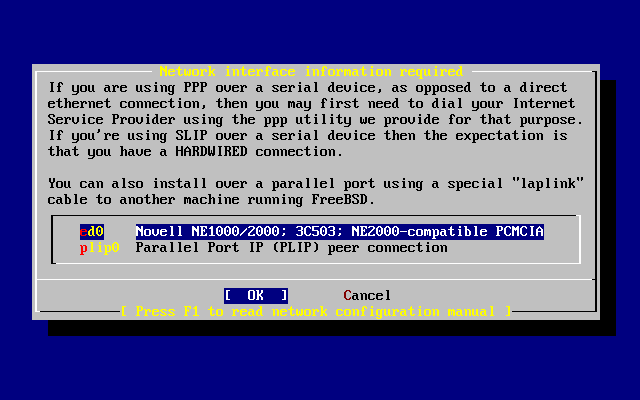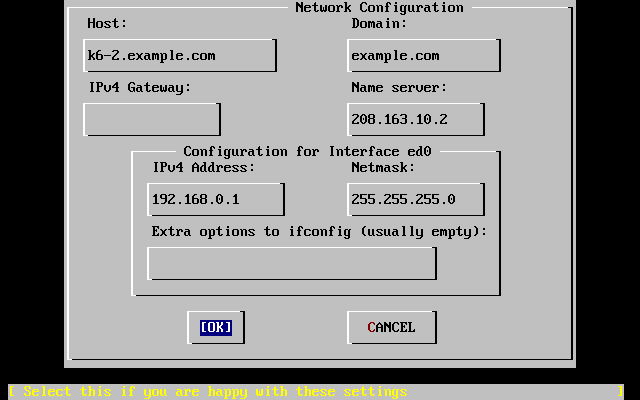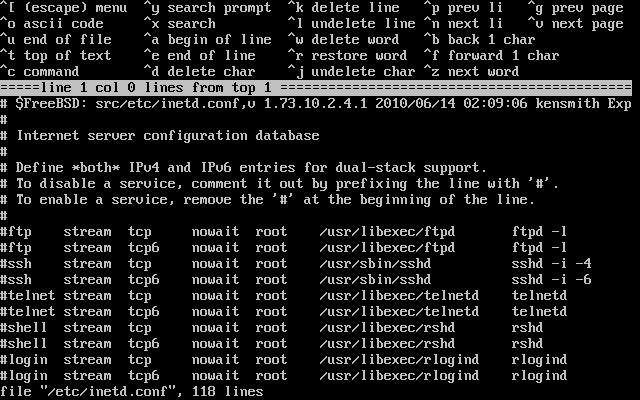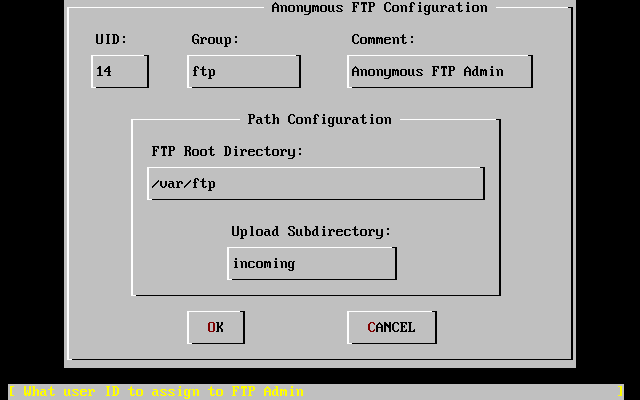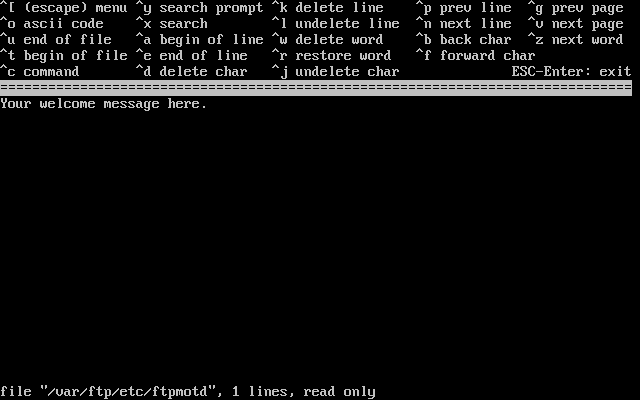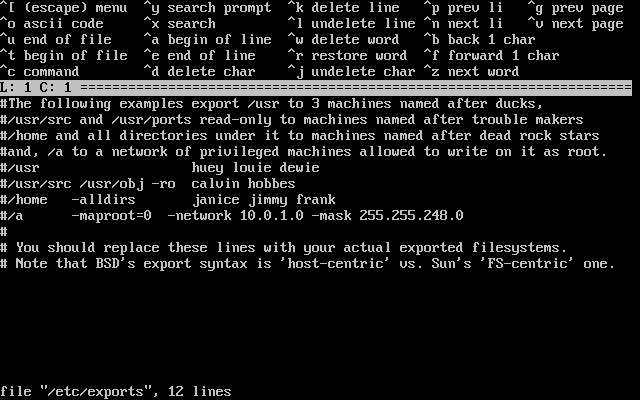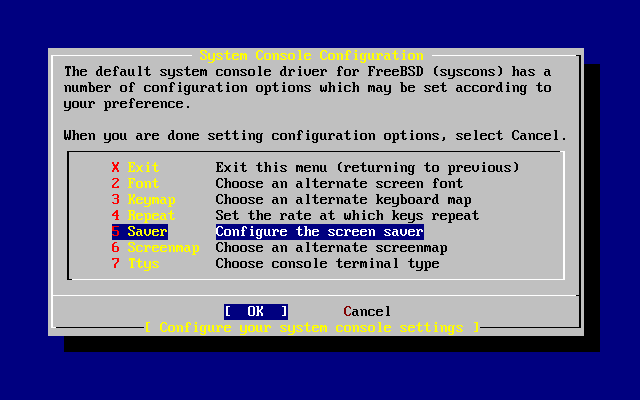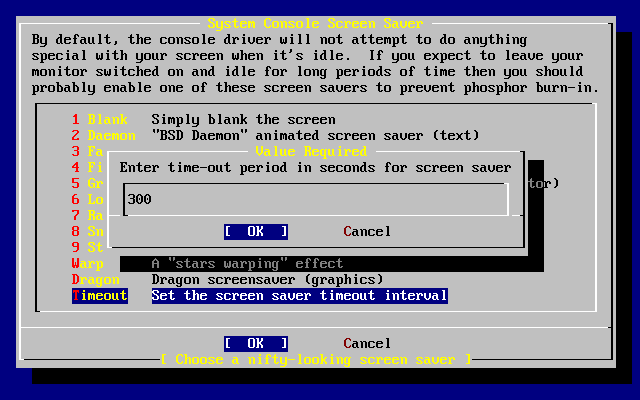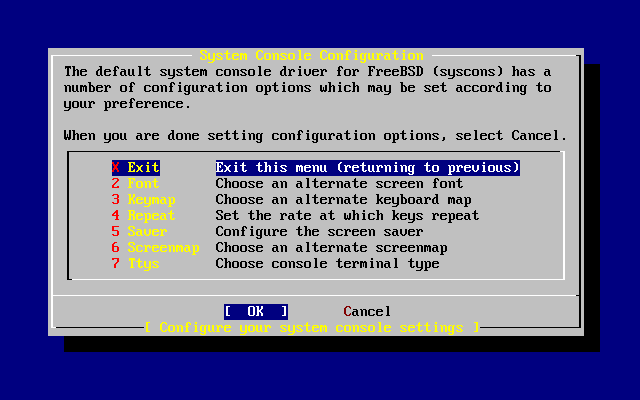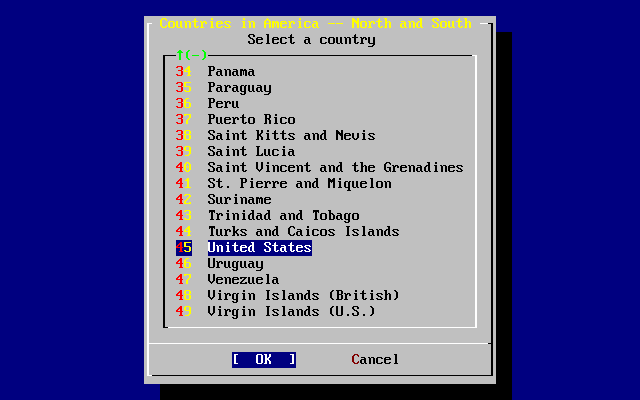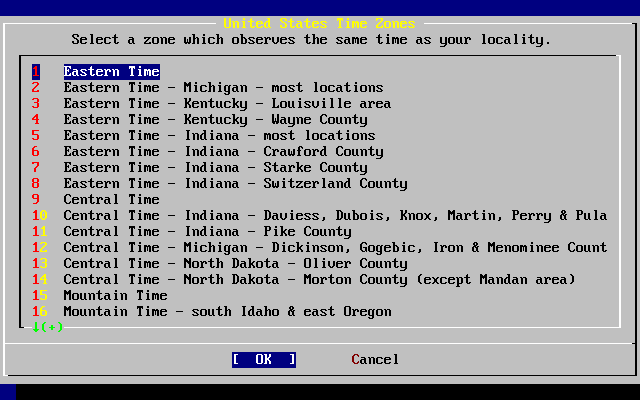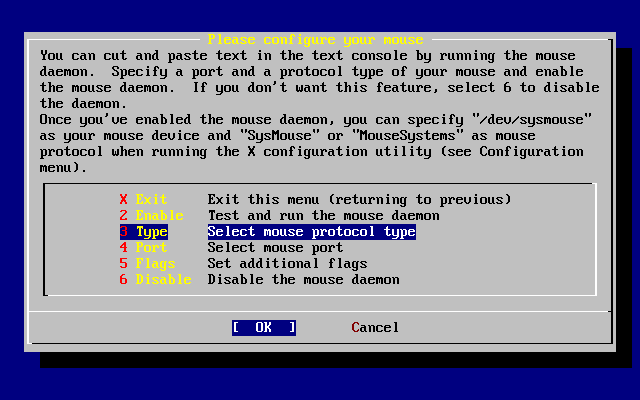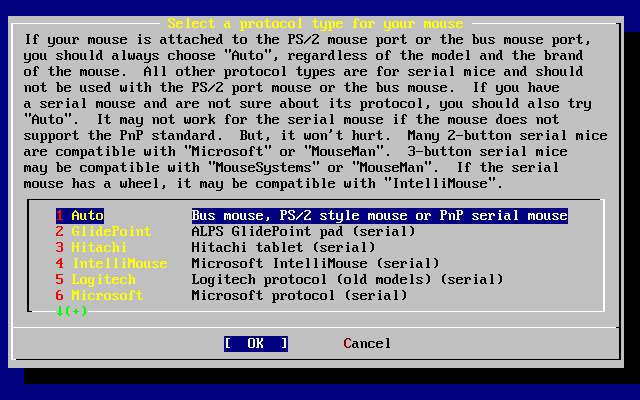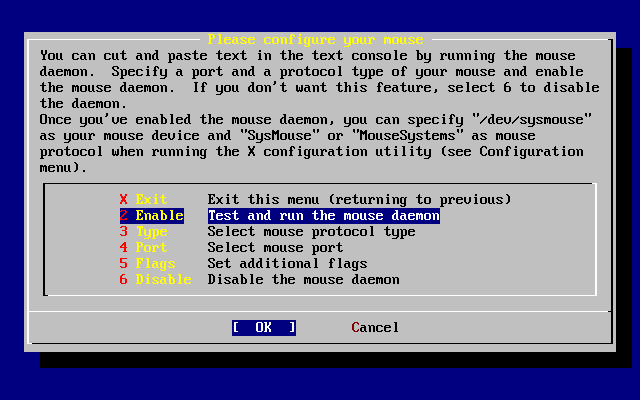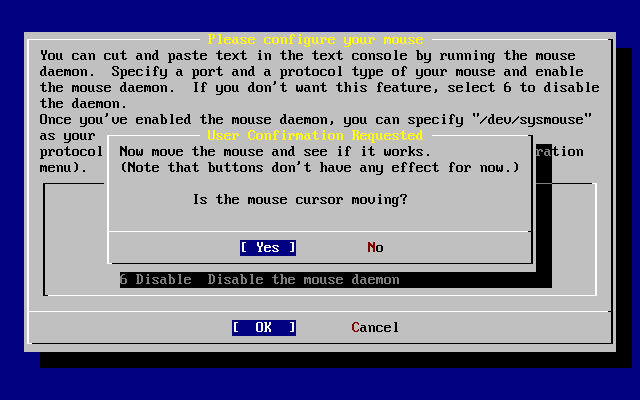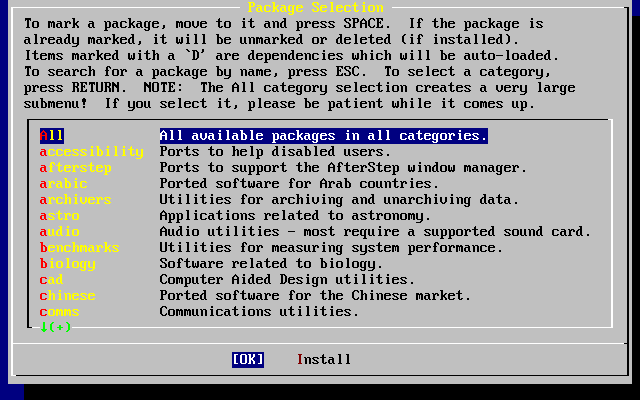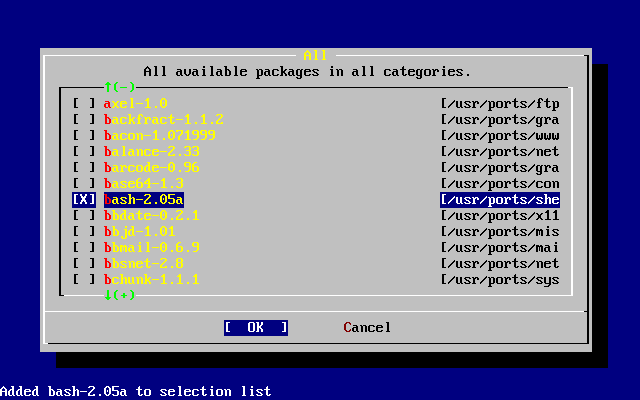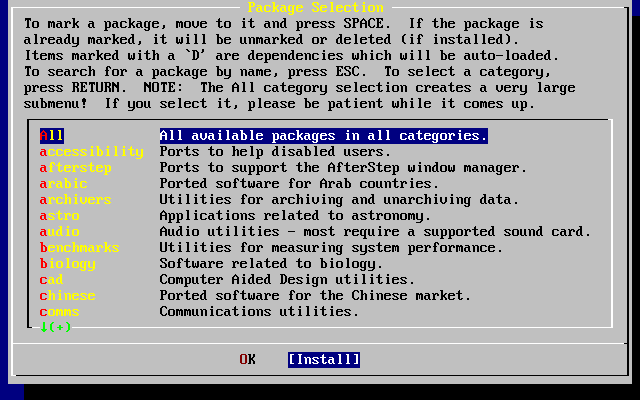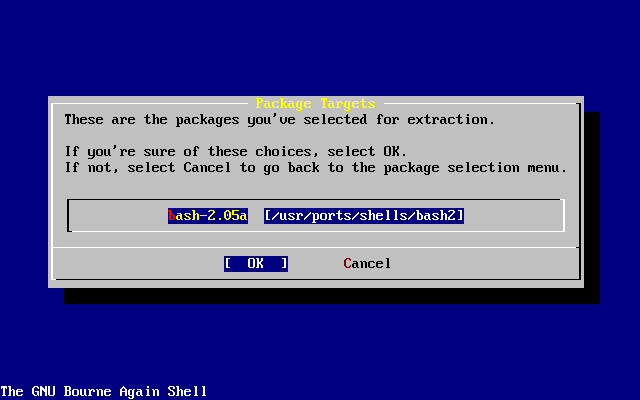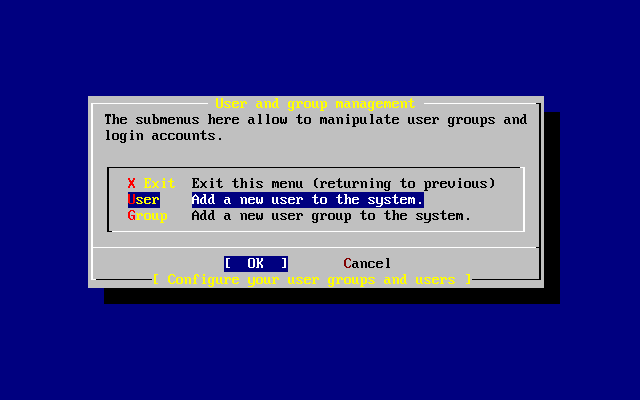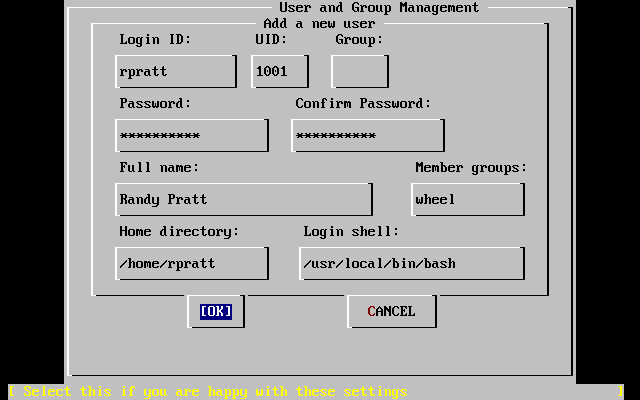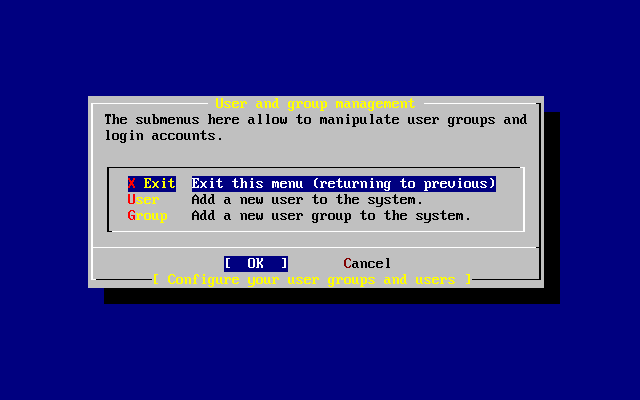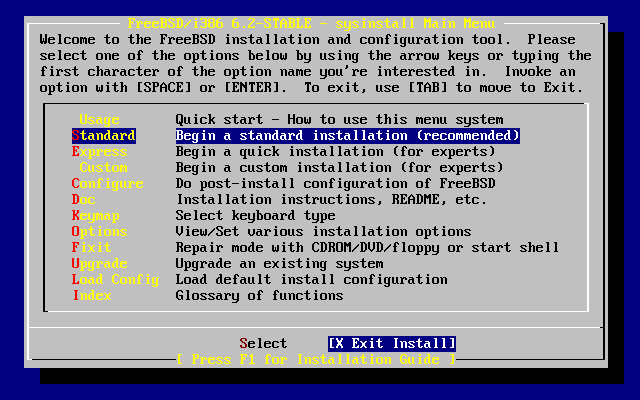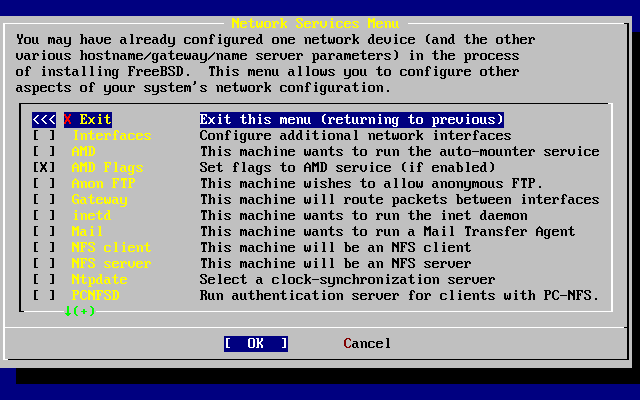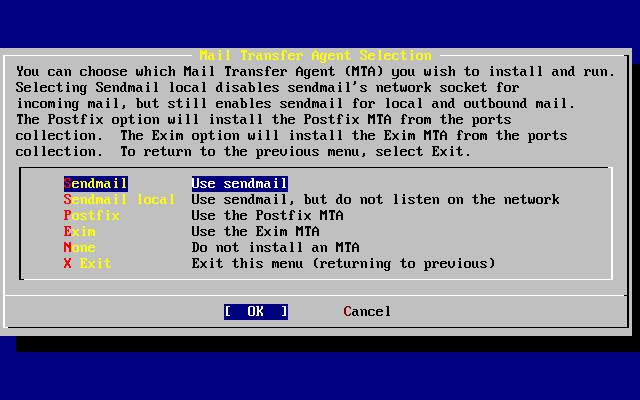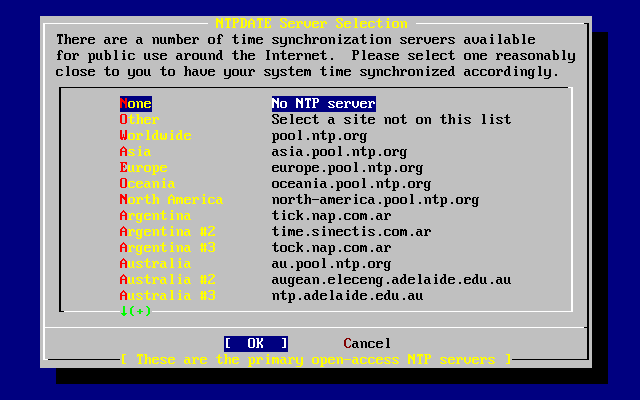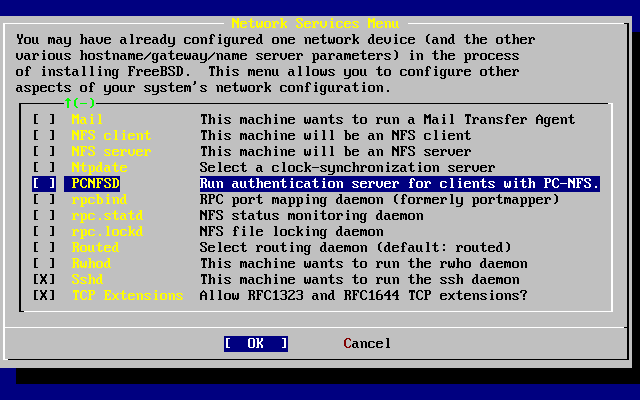Configuration of various options can be performed after a successful installation. An option can be configured by re-entering the configuration menus before booting the new FreeBSD system or after boot using sysinstall(8) and then selecting the menu.
If PPP was previously configured for an FTP install, this screen will not display and can be configured after boot as described above.
For detailed information on Local Area Networks and configuring FreeBSD as a gateway/router refer to the Advanced Networking chapter.
User Confirmation Requested
Would you like to configure any Ethernet or PPP network devices?
[ Yes ] NoTo configure a network device, select and press Enter. Otherwise, select to continue.
Select the interface to be configured with the arrow keys and press Enter.
User Confirmation Requested
Do you want to try IPv6 configuration of the interface?
Yes [ No ]In this private local area network, the current Internet type protocol (IPv4) was sufficient and was selected with the arrow keys and Enter pressed.
If connected to an existing IPv6 network with an RA server, choose and press Enter. It will take several seconds to scan for RA servers.
User Confirmation Requested
Do you want to try DHCP configuration of the interface?
Yes [ No ]If Dynamic Host Configuration Protocol DHCP) is not required, select with the arrow keys and press Enter.
Selecting will execute dhclient(8) and, if successful, will fill in the network configuration information automatically. Refer to Section 29.6, “Dynamic Host Configuration Protocol (DHCP)” for more information.
The following Network Configuration screen shows the configuration of the Ethernet device for a system that will act as the gateway for a Local Area Network.
Use Tab to select the information fields and fill in appropriate information:
- Host
The fully-qualified hostname, such as
k6-2.example.comin this case.- Domain
The name of the domain that the machine is in, such as
example.comfor this case.- IPv4 Gateway
IP address of host forwarding packets to non-local destinations. This must be filled in if the machine is a node on the network. Leave this field blank if the machine is the gateway to the Internet for the network. The IPv4 Gateway is also known as the default gateway or default route.
- Name server
IP address of the local DNS server. There is no local DNS server on this private local area network so the IP address of the provider's DNS server (
208.163.10.2) was used.- IPv4 address
The IP address to be used for this interface was
192.168.0.1- Netmask
The address block being used for this local area network is
192.168.0.0-192.168.0.255with a netmask of255.255.255.0.- Extra options to ifconfig(8)
Any additional interface-specific options to ifconfig(8). There were none in this case.
Use Tab to select when finished and press Enter.
User Confirmation Requested
Would you like to bring the ed0 interface up right now?
[ Yes ] NoChoosing and pressing Enter will bring the machine up on the network so it is ready for use. However, this does not accomplish much during installation, since the machine still needs to be rebooted.
User Confirmation Requested
Do you want this machine to function as a network gateway?
[ Yes ] NoIf the machine will be acting as the gateway for a local area network and forwarding packets between other machines, select and press Enter. If the machine is a node on a network, select and press Enter to continue.
User Confirmation Requested
Do you want to configure inetd and the network services that it provides?
Yes [ No ]If is selected, various services will not be
enabled. These services can be enabled after installation by
editing /etc/inetd.conf with a text
editor. See Section 29.2.1, “Configuration File” for more
information.
Otherwise, select to configure these services during install. An additional confirmation will display:
User Confirmation Requested
The Internet Super Server (inetd) allows a number of simple Internet
services to be enabled, including finger, ftp and telnetd. Enabling
these services may increase risk of security problems by increasing
the exposure of your system.
With this in mind, do you wish to enable inetd?
[ Yes ] NoSelect to continue.
User Confirmation Requested
inetd(8) relies on its configuration file, /etc/inetd.conf, to determine
which of its Internet services will be available. The default FreeBSD
inetd.conf(5) leaves all services disabled by default, so they must be
specifically enabled in the configuration file before they will
function, even once inetd(8) is enabled. Note that services for
IPv6 must be separately enabled from IPv4 services.
Select [Yes] now to invoke an editor on /etc/inetd.conf, or [No] to
use the current settings.
[ Yes ] NoSelecting allows services to be enabled by
deleting the # at the beginning of the
lines representing those services.
Once the edits are complete, press Esc to display a menu which will exit the editor and save the changes.
User Confirmation Requested
Would you like to enable SSH login?
Yes [ No ]Selecting will enable sshd(8), the daemon for OpenSSH. This allows secure remote access to the machine. For more information about OpenSSH, see Section 14.8, “OpenSSH”.
User Confirmation Requested
Do you want to have anonymous FTP access to this machine?
Yes [ No ]Selecting the default and pressing Enter will still allow users who have accounts with passwords to use FTP to access the machine.
Anyone can access the machine if anonymous FTP connections are allowed. The security implications should be considered before enabling this option. For more information about security, see Chapter 14, Security.
To allow anonymous FTP, use the arrow keys to select and press Enter. An additional confirmation will display:
User Confirmation Requested
Anonymous FTP permits un-authenticated users to connect to the system
FTP server, if FTP service is enabled. Anonymous users are
restricted to a specific subset of the file system, and the default
configuration provides a drop-box incoming directory to which uploads
are permitted. You must separately enable both inetd(8), and enable
ftpd(8) in inetd.conf(5) for FTP services to be available. If you
did not do so earlier, you will have the opportunity to enable inetd(8)
again later.
If you want the server to be read-only you should leave the upload
directory option empty and add the -r command-line option to ftpd(8)
in inetd.conf(5)
Do you wish to continue configuring anonymous FTP?
[ Yes ] NoThis message indicates that the FTP service will also
have to be enabled in /etc/inetd.conf
to allow anonymous FTP connections. Select and
press Enter to continue. The following
screen will display:
Use Tab to select the information fields and fill in appropriate information:
- UID
The user ID to assign to the anonymous FTP user. All files uploaded will be owned by this ID.
- Group
Which group to place the anonymous FTP user into.
- Comment
String describing this user in
/etc/passwd.- FTP Root Directory
Where files available for anonymous FTP will be kept.
- Upload Subdirectory
Where files uploaded by anonymous FTP users will go.
The FTP root directory will be put in
/var by default. If there is not
enough room there for the anticipated FTP needs, use
/usr instead by setting the FTP root
directory to /usr/ftp.
Once satisfied with the values, press Enter to continue.
User Confirmation Requested
Create a welcome message file for anonymous FTP users?
[ Yes ] NoIf is selected, press Enter and the ee(1) editor will automatically start.
Use the instructions to change the message. Note the file name location at the bottom of the editor screen.
Press Esc and a pop-up menu will default to . Press Enter to exit and continue. Press Enter again to save any changes.
The Network File System (NFS) allows sharing of files across a network. A machine can be configured as a server, a client, or both. Refer to Section 29.3, “Network File System (NFS)” for more information.
User Confirmation Requested
Do you want to configure this machine as an NFS server?
Yes [ No ]If there is no need for a NFS server, select and press Enter.
If is chosen, a message will pop-up indicating
that /etc/exports must be
created.
Message
Operating as an NFS server means that you must first configure an
/etc/exports file to indicate which hosts are allowed certain kinds of
access to your local filesystems.
Press [Enter] now to invoke an editor on /etc/exports
[ OK ]Press Enter to continue. A text editor
will start, allowing /etc/exports to be
edited.
Use the instructions to add the exported filesystems. Note the file name location at the bottom of the editor screen.
Press Esc and a pop-up menu will default to . Press Enter to exit and continue.
There are several options available to customize the system console.
User Confirmation Requested
Would you like to customize your system console settings?
[ Yes ] NoTo view and configure the options, select and press Enter.
A commonly used option is the screen saver. Use the arrow keys to select and then press Enter.
Select the desired screen saver using the arrow keys and then press Enter. The System Console Configuration menu will redisplay.
The default time interval is 300 seconds. To change the time interval, select again. At the Screen Saver Options menu, select using the arrow keys and press Enter. A pop-up menu will appear:
The value can be changed, then select and press Enter to return to the System Console Configuration menu.
Select and press Enter to continue with the post-installation configuration.
Setting the time zone allows the system to automatically correct for any regional time changes and perform other time zone related functions properly.
The example shown is for a machine located in the Eastern time zone of the United States. The selections will vary according to the geographic location.
User Confirmation Requested
Would you like to set this machine's time zone now?
[ Yes ] NoSelect and press Enter to set the time zone.
User Confirmation Requested
Is this machine's CMOS clock set to UTC? If it is set to local time
or you don't know, please choose NO here!
Yes [ No ]Select or according to how the machine's clock is configured, then press Enter.
The appropriate region is selected using the arrow keys and then pressing Enter.
Select the appropriate country using the arrow keys and press Enter.
The appropriate time zone is selected using the arrow keys and pressing Enter.
Confirmation
Does the abbreviation 'EDT' look reasonable?
[ Yes ] NoConfirm that the abbreviation for the time zone is correct. If it looks okay, press Enter to continue with the post-installation configuration.
This option allows cut and paste in the console and user programs using a 3-button mouse. If using a 2-button mouse, refer to moused(8) for details on emulating the 3-button style. This example depicts a non-USB mouse configuration:
User Confirmation Requested
Does this system have a PS/2, serial, or bus mouse?
[ Yes ] No Select for a PS/2, serial, or bus mouse, or for a USB mouse, then press Enter.
Use the arrow keys to select and press Enter.
The mouse used in this example is a PS/2 type, so the default is appropriate. To change the mouse protocol, use the arrow keys to select another option. Ensure that is highlighted and press Enter to exit this menu.
Use the arrow keys to select and press Enter.
This system had a PS/2 mouse, so the default is appropriate. To change the port, use the arrow keys and then press Enter.
Last, use the arrow keys to select , and press Enter to enable and test the mouse daemon.
Move the mouse around the screen to verify that the cursor responds properly. If it does, select and press Enter. If not, the mouse has not been configured correctly. Select and try using different configuration options.
Select with the arrow keys and press Enter to continue with the post-installation configuration.
Packages are pre-compiled binaries and are a convenient way to install software.
Installation of one package is shown for purposes of illustration. Additional packages can also be added at this time if desired. After installation, sysinstall(8) can be used to add additional packages.
User Confirmation Requested
The FreeBSD package collection is a collection of hundreds of
ready-to-run applications, from text editors to games to WEB servers
and more. Would you like to browse the collection now?
[ Yes ] NoSelect and press Enter to be presented with the Package Selection screens:
Only packages on the current installation media are available for installation at any given time.
All packages available will be displayed if is selected. Otherwise, select a particular category. Highlight the selection with the arrow keys and press Enter.
A menu will display showing all the packages available for the selection made:
The bash shell is shown as selected. Select as many packages as desired by highlighting the package and pressing Space. A short description of each package will appear in the lower left corner of the screen.
Press Tab to toggle between the last selected package, , and .
Once finished marking the packages for installation, press Tab once to toggle to and press Enter to return to the Package Selection menu.
The left and right arrow keys will also toggle between and . This method can also be used to select and press Enter to return to the Package Selection menu.
Use the Tab and arrow keys to select and press Enter to see the installation confirmation message:
Select and press Enter to start the package installation. Installation messages will appear until all of the installations have completed. Make note if there are any error messages.
The final configuration continues after packages are installed. If no packages are selected, select to return to the final configuration.
Add at least one user during the installation so that the
system can be used without logging in as root. The root partition is
generally small and running applications as root can quickly fill it. A
bigger danger is noted below:
User Confirmation Requested
Would you like to add any initial user accounts to the system? Adding
at least one account for yourself at this stage is suggested since
working as the "root" user is dangerous (it is easy to do things which
adversely affect the entire system).
[ Yes ] NoSelect and press Enter to continue with adding a user.
Select with the arrow keys and press Enter.
The following descriptions will appear in the lower part of the screen as the items are selected with Tab to assist with entering the required information:
- Login ID
The login name of the new user (mandatory).
- UID
The numerical ID for this user (leave blank for automatic choice).
- Group
The login group name for this user (leave blank for automatic choice).
- Password
The password for this user (enter this field with care!).
- Full name
The user's full name (comment).
- Member groups
The groups this user belongs to.
- Home directory
The user's home directory (leave blank for default).
- Login shell
The user's login shell (leave blank for default of
/bin/sh).
In this example, the login shell was changed from
/bin/sh to
/usr/local/bin/bash to use the
bash shell that was previously
installed as a package. Do not use a shell that does not
exist or the user will not be able to login. The most common
shell used in FreeBSD is the C shell,
/bin/tcsh.
The user was also added to the wheel group to be able to
become a superuser with root privileges.
Once satisfied, press and the User and Group Management menu will redisplay:
Groups can also be added at this time. Otherwise, this menu may be accessed using sysinstall(8) at a later time.
When finished adding users, select with the arrow keys and press Enter to continue the installation.
Message
Now you must set the system manager's password.
This is the password you'll use to log in as "root".
[ OK ]
[ Press enter or space ]Press Enter to set the root password.
The password will need to be typed in twice correctly. Do not forget this password. Notice that the typed password is not echoed, nor are asterisks displayed.
New password: Retype new password :
The installation will continue after the password is successfully entered.
A message will ask if configuration is complete:
User Confirmation Requested
Visit the general configuration menu for a chance to set any last
options?
Yes [ No ]Select with the arrow keys and press Enter to return to the Main Installation Menu.
Select with the arrow keys and press Enter. The installer will prompt to confirm exiting the installation:
User Confirmation Requested
Are you sure you wish to exit? The system will reboot.
[ Yes ] NoSelect . If booting from the CDROM drive, the following message will remind you to remove the disk:
Message
Be sure to remove the media from the drive.
[ OK ]
[ Press enter or space ]The CDROM drive is locked until the machine starts to reboot, then the disk can quickly be removed from the drive. Press to reboot.
The system will reboot so watch for any error messages that may appear, see Section 3.10.15, “FreeBSD Bootup” for more details.
Configuring network services can be a daunting task for users that lack previous knowledge in this area. Since networking and the Internet are critical to all modern operating systems, it is useful to have some understanding of FreeBSD's extensive networking capabilities.
Network services are programs that accept input from
anywhere on the network. Since there have been cases where
bugs in network services have been exploited by attackers, it
is important to only enable needed network services. If in
doubt, do not enable a network service until it is needed.
Services can be enabled with sysinstall(8) or by editing
/etc/rc.conf.
Selecting the option will display a menu similar to the one below:
The first option, , is covered in Section 3.10.1, “Network Device Configuration”.
Selecting the option adds support for amd(8). This is usually used in conjunction with NFS for automatically mounting remote filesystems.
Next is the option. When selected, a menu will pop up where specific AMD flags can be entered. The menu already contains a set of default options:
-a /.amd_mnt -l syslog /host /etc/amd.map /net /etc/amd.map
-a sets the default mount location which
is specified here as /.amd_mnt.
-l specifies the default
log; however, when syslogd(8) is
used, all log activity will be sent to the system log daemon.
/host is used to mount an exported file
system from a remote host, while /net
is used to mount an exported filesystem from an
IP address. The default options for
AMD exports are defined in
/etc/amd.map.
The option permits anonymous FTP connections. Select this option to make this machine an anonymous FTP server. Be aware of the security risks involved with this option. Another menu will be displayed to explain the security risks and configuration in depth.
The menu will configure the machine to be a gateway. This menu can also be used to unset the option if it was accidentally selected during installation.
The option can be used to configure or completely disable inetd(8).
The option is used to configure the system's default Mail Transfer Agent (MTA). Selecting this option will bring up the following menu:
This menu offers a choice as to which MTA to install and set as the default. An MTA is a mail server which delivers email to users on the system or the Internet.
Select to install Sendmail as the default MTA. Select to set Sendmail as the default MTA, but disable its ability to receive incoming email from the Internet. The other options, and , provide alternatives to Sendmail.
The next menu after the MTA menu is . This menu is used to configure the system to communicate with a NFS server which in turn is used to make filesystems available to other machines on the network over the NFS protocol. See Section 29.3, “Network File System (NFS)” for more information about client and server configuration.
Below that option is the option, for setting the system up as an NFS server. This adds the required information to start up the Remote Procedure Call RPC services. RPC is used to coordinate connections between hosts and programs.
Next in line is the option, which deals with time synchronization. When selected, a menu like the one below shows up:
From this menu, select the server which is geographically closest. This will make the time synchronization more accurate as a farther server may have more connection latency.
The next option is the PCNFSD selection. This option will install the net/pcnfsd package from the Ports Collection. This is a useful utility which provides NFS authentication services for systems which are unable to provide their own, such as Microsoft's MS-DOS® operating system.
Now, scroll down a bit to see the other options:
RPC communication between
NFS servers and clients is managed by
rpcbind(8) which is required for NFS
servers to operate correctly. Status monitoring is provided
by rpc.statd(8) and the reported status is usually held
in /var/db/statd.status. The next option
is for rpc.lockd(8) which provides file locking
services. This is usually used with rpc.statd(8) to
monitor which hosts are requesting locks and how frequently
they request them. While these last two options are useful
for debugging, they are not required for
NFS servers and clients to operate
correctly.
The next menu, ,
configures the routing daemon. routed(8), manages
network routing tables, discovers multicast routers, and
supplies a copy of the routing tables to any physically
connected host on the network upon request. This is mainly
used for machines which act as a gateway for the local
network. If selected, a menu will request the default
location of the utility. To accept the default location,
press Enter. Yet another menu will ask for
the flags to pass to routed(8). The default of
-q should appear on the screen.
The next menu, , starts rwhod(8) during system initialization. This utility broadcasts system messages across the network periodically, or collects them when in “consumer” mode. More information can be found in ruptime(1) and rwho(1).
The next to last option in the list is for sshd(8), the secure shell server for OpenSSH. It is highly recommended over the standard telnetd(8) and ftpd(8) servers as it is used to create a secure, encrypted connection from one host to another.
The final option is which are defined in RFC 1323 and RFC 1644. While on many hosts this can speed up connections, it can also cause some connections to be dropped. It is not recommended for servers, but may be beneficial for stand alone machines.
Once the network services are configured, scroll up to the very top item which is and continue on to the next configuration item or simply exit sysinstall(8) by selecting twice then .
If everything went well, messages will scroll along the screen and a login prompt will appear. To view these messages, press Scroll-Lock then use PgUp and PgDn. Press Scroll-Lock again to return to the prompt.
All of the messages may not display due to buffer limitations, but they can be read after logging using dmesg(8).
Login using the username and password which were set
during installation. Avoid logging in as root except when
necessary.
Typical boot messages (version information omitted):
Copyright (c) 1992-2002 The FreeBSD Project.
Copyright (c) 1979, 1980, 1983, 1986, 1988, 1989, 1991, 1992, 1993, 1994
The Regents of the University of California. All rights reserved.
Timecounter "i8254" frequency 1193182 Hz
CPU: AMD-K6(tm) 3D processor (300.68-MHz 586-class CPU)
Origin = "AuthenticAMD" Id = 0x580 Stepping = 0
Features=0x8001bf<FPU,VME,DE,PSE,TSC,MSR,MCE,CX8,MMX>
AMD Features=0x80000800<SYSCALL,3DNow!>
real memory = 268435456 (262144K bytes)
config> di sn0
config> di lnc0
config> di le0
config> di ie0
config> di fe0
config> di cs0
config> di bt0
config> di aic0
config> di aha0
config> di adv0
config> q
avail memory = 256311296 (250304K bytes)
Preloaded elf kernel "kernel" at 0xc0491000.
Preloaded userconfig_script "/boot/kernel.conf" at 0xc049109c.
md0: Malloc disk
Using $PIR table, 4 entries at 0xc00fde60
npx0: <math processor> on motherboard
npx0: INT 16 interface
pcib0: <Host to PCI bridge> on motherboard
pci0: <PCI bus> on pcib0
pcib1: <VIA 82C598MVP (Apollo MVP3) PCI-PCI (AGP) bridge> at device 1.0 on pci0
pci1: <PCI bus> on pcib1
pci1: <Matrox MGA G200 AGP graphics accelerator> at 0.0 irq 11
isab0: <VIA 82C586 PCI-ISA bridge> at device 7.0 on pci0
isa0: <ISA bus> on isab0
atapci0: <VIA 82C586 ATA33 controller> port 0xe000-0xe00f at device 7.1 on pci0
ata0: at 0x1f0 irq 14 on atapci0
ata1: at 0x170 irq 15 on atapci0
uhci0: <VIA 83C572 USB controller> port 0xe400-0xe41f irq 10 at device 7.2 on pci0
usb0: <VIA 83C572 USB controller> on uhci0
usb0: USB revision 1.0
uhub0: VIA UHCI root hub, class 9/0, rev 1.00/1.00, addr 1
uhub0: 2 ports with 2 removable, self powered
chip1: <VIA 82C586B ACPI interface> at device 7.3 on pci0
ed0: <NE2000 PCI Ethernet (RealTek 8029)> port 0xe800-0xe81f irq 9 at
device 10.0 on pci0
ed0: address 52:54:05:de:73:1b, type NE2000 (16 bit)
isa0: too many dependant configs (8)
isa0: unexpected small tag 14
fdc0: <NEC 72065B or clone> at port 0x3f0-0x3f5,0x3f7 irq 6 drq 2 on isa0
fdc0: FIFO enabled, 8 bytes threshold
fd0: <1440-KB 3.5" drive> on fdc0 drive 0
atkbdc0: <keyboard controller (i8042)> at port 0x60-0x64 on isa0
atkbd0: <AT Keyboard> flags 0x1 irq 1 on atkbdc0
kbd0 at atkbd0
psm0: <PS/2 Mouse> irq 12 on atkbdc0
psm0: model Generic PS/2 mouse, device ID 0
vga0: <Generic ISA VGA> at port 0x3c0-0x3df iomem 0xa0000-0xbffff on isa0
sc0: <System console> at flags 0x1 on isa0
sc0: VGA <16 virtual consoles, flags=0x300>
sio0 at port 0x3f8-0x3ff irq 4 flags 0x10 on isa0
sio0: type 16550A
sio1 at port 0x2f8-0x2ff irq 3 on isa0
sio1: type 16550A
ppc0: <Parallel port> at port 0x378-0x37f irq 7 on isa0
ppc0: SMC-like chipset (ECP/EPP/PS2/NIBBLE) in COMPATIBLE mode
ppc0: FIFO with 16/16/15 bytes threshold
ppbus0: IEEE1284 device found /NIBBLE
Probing for PnP devices on ppbus0:
plip0: <PLIP network interface> on ppbus0
lpt0: <Printer> on ppbus0
lpt0: Interrupt-driven port
ppi0: <Parallel I/O> on ppbus0
ad0: 8063MB <IBM-DHEA-38451> [16383/16/63] at ata0-master using UDMA33
ad2: 8063MB <IBM-DHEA-38451> [16383/16/63] at ata1-master using UDMA33
acd0: CDROM <DELTA OTC-H101/ST3 F/W by OIPD> at ata0-slave using PIO4
Mounting root from ufs:/dev/ad0s1a
swapon: adding /dev/ad0s1b as swap device
Automatic boot in progress...
/dev/ad0s1a: FILESYSTEM CLEAN; SKIPPING CHECKS
/dev/ad0s1a: clean, 48752 free (552 frags, 6025 blocks, 0.9% fragmentation)
/dev/ad0s1f: FILESYSTEM CLEAN; SKIPPING CHECKS
/dev/ad0s1f: clean, 128997 free (21 frags, 16122 blocks, 0.0% fragmentation)
/dev/ad0s1g: FILESYSTEM CLEAN; SKIPPING CHECKS
/dev/ad0s1g: clean, 3036299 free (43175 frags, 374073 blocks, 1.3% fragmentation)
/dev/ad0s1e: filesystem CLEAN; SKIPPING CHECKS
/dev/ad0s1e: clean, 128193 free (17 frags, 16022 blocks, 0.0% fragmentation)
Doing initial network setup: hostname.
ed0: flags=8843<UP,BROADCAST,RUNNING,SIMPLEX,MULTICAST> mtu 1500
inet 192.168.0.1 netmask 0xffffff00 broadcast 192.168.0.255
inet6 fe80::5054::5ff::fede:731b%ed0 prefixlen 64 tentative scopeid 0x1
ether 52:54:05:de:73:1b
lo0: flags=8049<UP,LOOPBACK,RUNNING,MULTICAST> mtu 16384
inet6 fe80::1%lo0 prefixlen 64 scopeid 0x8
inet6 ::1 prefixlen 128
inet 127.0.0.1 netmask 0xff000000
Additional routing options: IP gateway=YES TCP keepalive=YES
routing daemons:.
additional daemons: syslogd.
Doing additional network setup:.
Starting final network daemons: creating ssh RSA host key
Generating public/private rsa1 key pair.
Your identification has been saved in /etc/ssh/ssh_host_key.
Your public key has been saved in /etc/ssh/ssh_host_key.pub.
The key fingerprint is:
cd:76:89:16:69:0e:d0:6e:f8:66:d0:07:26:3c:7e:2d [email protected]
creating ssh DSA host key
Generating public/private dsa key pair.
Your identification has been saved in /etc/ssh/ssh_host_dsa_key.
Your public key has been saved in /etc/ssh/ssh_host_dsa_key.pub.
The key fingerprint is:
f9:a1:a9:47:c4:ad:f9:8d:52:b8:b8:ff:8c:ad:2d:e6 [email protected].
setting ELF ldconfig path: /usr/lib /usr/lib/compat /usr/X11R6/lib
/usr/local/lib
a.out ldconfig path: /usr/lib/aout /usr/lib/compat/aout /usr/X11R6/lib/aout
starting standard daemons: inetd cron sshd usbd sendmail.
Initial rc.i386 initialization:.
rc.i386 configuring syscons: blank_time screensaver moused.
Additional ABI support: linux.
Local package initialization:.
Additional TCP options:.
FreeBSD/i386 (k6-2.example.com) (ttyv0)
login: rpratt
Password:Generating the RSA and DSA keys may take some time on slower machines. This happens only on the initial boot-up of a new installation. Subsequent boots will be faster.
If Xorg has been configured
and a default desktop chosen, it can be started by typing
startx at the command line.
It is important to properly shutdown the operating system.
Do not just turn off the power. First, become the superuser
using su(1) and entering the root password. This will work
only if the user is a member of wheel. Otherwise, login as
root. To shutdown
the system, type shutdown -h now.
The operating system has halted. Please press any key to reboot.
It is safe to turn off the power after the shutdown command has been issued and the message “Please press any key to reboot” appears. If any key is pressed instead of turning off the power switch, the system will reboot.
The Ctrl+Alt+Del key combination can also be used to reboot the system; however, this is not recommended.
